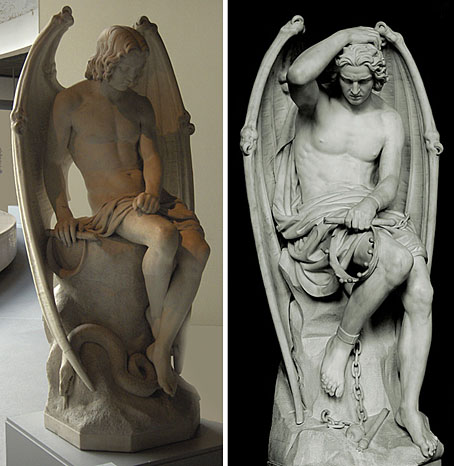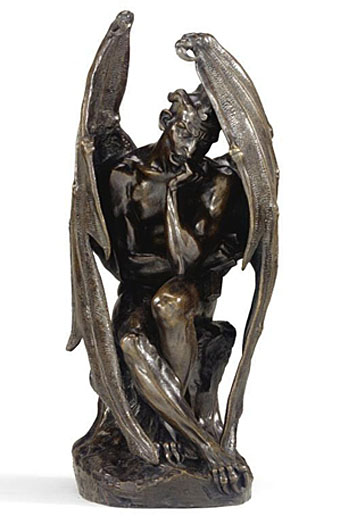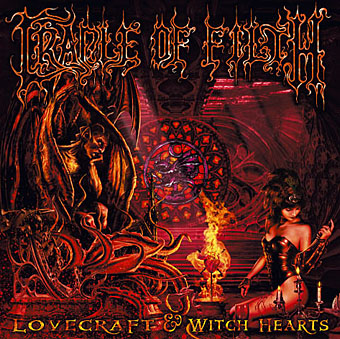Satan (1833).
I always enjoy it when a search for a piece of information about an artist leads to works you hadn’t come across before. Today it was a quest for the identity of the Satan statue above, created, as it turns out, by French sculptor Jean-Jacques Feuchère (1807–1852). The Louvre site has another view of what seems to have been a popular work, produced in a range of bronzes.
I did actually know the artist’s name a few years ago since I’d used the statue as a starting point for the Satan figure on the cover of Cradle of Filth’s Lovecraft & Witch Hearts in 2002. One function of postings such as this is that it allows me to make a note of details which otherwise might flee the memory. Here Feuchère’s statue was combined with some squid tentacles and seated on an elaborate Gothic throne which is mostly obscured by the band’s name. (See a larger version sans lettering here.)

left: L’ange du mal (1842); right: Le génie du mal (1848).
And the search for Monsieur Feuchère led to this pair of brooding archangels by Belgian sculptors, two of the Brothers Geefs, Joseph (1808–1885) and Guillaume (1805–1883). L’ange du mal (1842) proved to be too alluring (and perhaps too nude) for its intended siting in St Paul’s Cathedral, Liège. The Royal Museum of Fine Arts of Belgium (which now houses the work) has this to say:
Joseph Geefs and his younger brother Guillaume are associated with the turbulent history of “The Genius of Evil”, which was commissioned to Guillaume in 1837 for the St Paul’s Cathedral in Liège. However, the one that was sited in 1843 bore Joseph’s signature. ‘As it did not convey the Christian idea,’ it was soon taken down. “The Genius of Evil” illustrates the attraction to the dark side, the chasm, in the course of the Romantic period. Far from instilling revulsion, its chiropteran wings form a casing that enhances the beauty of a young body. At the same time it better illustrates the trend in the Romantic movement towards rehabilitating the rebellious Fallen Angel.
Guillaume played safe by exaggerating the torment and the symbolism with shackles, a broken crown and even a bitten apple at the angel’s feet. All the same, this still seems a surprising work to sit in a cathedral. As Milton demonstrated, the danger for Christians in focusing on the trials of Lucifer is that his figure inspires sympathy. This was part of the attraction for the Romantics; God is omnipotent but Lucifer still chooses to rebel. That ideal became increasingly attractive throughout the 19th century and inspired further artworks, some of which have been featured here already. There’s a lot more out there so I can see I’ll be returning to this subject.
Previously on { feuilleton }
• The art of Félicien Rops, 1833–1898
• Angels 4: Fallen angels



It never fails to amuse me when the Church gets more than it bargained for. And I love the bat- wings on these statues. They remind me of the cover to a Greek edition of Dracula I read when I was a kid. The cover was Dore’s Paradise Lost engraving, but the principle is the same, I think.
Was there a similar inspiration for the woman on the Craddle Of Filth cover John? Her posture seems a bit familiar. It could be just the fact that their artwork often features images of succubi though.
Hi Dimitris. No, the “witch” was collaged together from several different photos, as was the rest of the picture for that matter. I’ve uploaded a larger version of the artwork here which shows more of the detail. A primary component of most CoF artwork was an alluring female presence.
I like the claws on the top Lucifer’s feet, if I had to name any major aesthetic fixation I have then claws / talons would be somewhere near the top. Really, as a general rule of thumb any kind of sharp bodily protrusion i.e. horns, fangs, spines, and what-have-you, hell anything sharp at all probably.
Claws are special though.
If you look at the feet of Le génie du mal in the big Wikimedia version you’ll see that he has sharp toenails as well. One of many nice details on that statue.
I’m always fascinated by the wings on these things. Careful decisions need to be made if you’re going to carve something so elaborate. Did the artists study the articulation of bats’ wings first?
awesomenes is in this page